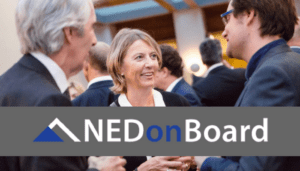This blog features a conversation between Bryan Foss, a co-founder of the Risk Coalition and a non-executive director and Dr Roger Miles, a researcher and author on human-factor risks, improvement of conduct and related controls. This article should be read in conjunction with the highlights of the Diversity in Risk Thinking event organised by NEDonBoard in May 2020. Related post: Diversity in Risk Thinking event insights
Bryan Foss met with Dr Roger Miles to develop diversity within financial services, specifically related to improving risk and governance accountability and outcomes under the Senior Managers and Certification Regime (SM&CR) .
A subsequent panel debate for NEDonBoard members asked that the Risk Coalition capture Roger’s thoughts for consideration and practical board application. Here they are in his Q&A with Bryan!
You’ve said that ‘Diversity takes diverse forms’… Which diversity indicator best predicts for team performance?
(Roger’s answer). It’s great that we’re all using a wider range of diversity indicators now – gender, ethnicity, social origins and so on – but the best indicator is none of the above, it’s a thing called cognitive diversity. In simple terms, that’s your capacity to consider problems in new ways, free from preconceptions. Often that’s embodied by a mix in the room of all the other diversity factors, plus some other new elements such as your mix of non-neurotypicals.
How have corporate health indicators of Value and Purpose changed?
The whole conduct project asks us to take a fresh look at the way we report value and purpose in business. In the past we’ve looked to classic indicators of business financial health such as capitalisation, efficiency, solvency, profitability – the things you are used to seeing in an annual report from a public company.
Now, we’re looking for assurances about how well the business looks after its human relationships, with staff and customers, and with the wider stakeholder surround including suppliers, the public, politicians, and so on. To be able to give this assurance you need to verify that you have, and can point to, a culture based on psychological safety: mostly simply tested by, how far is each member of staff really comfortable that they can ask a serious question without fear of reprisal?
Psychological Safety itself rests on several elements such as diversity, moral courage, and people’s personal understanding of their firm’s social licence. On that last point, how situationally alert are staff and senior managers, meaning how routinely tuned-in are they to the topics that customers, investors, regulators, supply-chain partners and fellow employees most care about today? And if they are, how do they share this knowledge?
What is the problem of the ‘work tribe’?
One reason why we engage in any collective activity, whether it’s social zoom calls, a sports club, or going to work in an office, is that we evolved as human animals to be sociable creatures; we’re best suited to living in tribes. We find it comforting to be surrounded by people who think the same way, who reflect our perspectives, who confirm our views. This, we feel, validates our world view and it stimulates the pleasure centres of our brains, like a hidden gravitational force, reassuring us and making us feel safe.
But, of course, you’ll have spotted there is a problem in there. Although our brain chemistry rewards us for the pleasure of living in this echo chamber, unfortunately it does nothing to challenge our unconscious biases against ‘other ways of doing things’. We all have unconscious biases as a product of our upbringing and whilst many of these are harmless, they may take socially unacceptable forms, ranging from “micro-aggressions” that distress colleagues to more obvious blind spots in empathy. Ironically, these undermine the very sense of common purpose and cohesion that a tribal social structure evolved to develop. Whether or not we recognise it, whenever we are looking to hire a team colleague our unconscious biases are at work encouraging us to hire the person who most fits our preconception of what a supportive member of the tribe looks like – a stereotype based on, as often as not, its current members.
To overcome this problem, we need to strive to look beyond our innate preference for “more of the same” and to make a conscious effort to welcome challenge from diverse thinkers. Consider the alternative: if everyone in your team has a similar view of how the world works, based on their family upbringing, system of education, and so on, nobody is likely to bring to the table an alternative viewpoint, let alone to anticipate what a competing interest might be about to do. If you get people around you who routinely consider alternative and dissenting views, based on a wider variety of different experiences of their own, not only will you get a richer and more accurate view of the world – you’ll spot and solve business problems far earlier.
Related post: NEDonBoard: Diversity & Inclusion press release
Why is cognitive diversity the key to better risk oversight?
As a general premise, the greater the range of human experience you bring to bear on identifying a problem, the better you’ll be able to overcome it. Being able to draw on a resource of people with a wider range of ways of thinking and life-experiences helps avoid the collective blindness brought on by “assumed framing” of a topic; it prevents the onset of groupthink – a condition where people suppress their own divergent thinking, usually out of undue deference to the status of the group they’re in, such as board or senior committee meeting.
Yet, healthy challenge is vital to prevent overconfidence and, at its best, is transformative. The biggest leaps forward occur when groups of people don’t just pursue incremental change but recombine – exchanging and merging ideas from different fields. In plain parochial terms of conduct reporting, rather than high strategy, adopting this approach is a simple way to show that your “challenge function” is working, which of course keeps conduct regulators happy as well as improving your grasp of risk.
What new reporting or MI is a good example of regulated conduct in relation to risk oversight?
At the slight risk of oversimplifying the ethical landscape I like to divide conduct reporting into, on the one side, the virtues and on the other, their evil twins. In current regulatory jargon some of the most valued virtues are psychological safety, moral courage, reflexivity, cognitive diversity, and intellectual humility. The evil twins of these are respectively, abusive behaviour, by-standing, pointless habits, stereotyping and motivated reasoning.
The good news is that behavioural research already exists to identify reporting MI for all ten of these factors. The even better news is that you don’t in fact need fancy academic models to derive meaningful observation-based MI for most of them.
Let’s take just two easy example indicators. Rather than running an elaborate and unnerving all-staff survey on psychological safety, you could simply look at entries on the website Glassdoor.com, where staff past and present are already publishing their frank appraisals of your culture. If you’re unsure whether you have a problem with by-standing (that is, a culture of denying or dodging problems) take a look at how many workarounds of various kinds are around you in your business – creative dodges, expedients that people use to skip over the problem rather than to address it.
By the way, it’s not just IT people who use workarounds, though they perhaps most often use the phrase; everybody does this from time to time. Some other industries even give the practice a fancy risk register label such as “authorised deviations”, but they’re still the same thing – creative ways of putting off addressing an underlying problem.
So yes, we could go the route of importing fancy academic MI tools such as the Active Open-Mindedness Scale, or the Implicit Association Test, or Cultural Cognition. Or we can walk more directly towards the issue and make some practical changes. Simply reorganise senior managers’ diaries to make sure that they spend more time “socialising risk learning” – that is, having informal, status-free conversations with people at all levels across the business, staying alert for early and weak signals of risk. Do more ‘Town Hall’ meetings and configure them so they really work (most firms’ don’t, by the way). Introduce time for challenge and blue-sky discussion into board and committee schedules.
Finally let’s not lose sight of, for me, for now, our two best “silver bullet” indicators. These are the behavioural MIs that correlate most clearly to business value (as well as, of course, virtuous conduct in the regulated sense): cognitive diversity and psychological safety. Where these two are present, you will keep your best staff, spot problems sooner, solve them better, innovate and build business, have more loyal, better quality clients. Obvious benefits in terms of business running costs but also a big long-term boost to the retained value of the business.
Additional resources:
NED diversity and inclusion in privately owned firms
Culture, diversity and inclusion for board members
Want to know more?
NEDonBoard is a leading provider of educational content for non-executive directors and board members. Access the resources center of the NEDonBoard member website NED Library and Board Best Practices, or email us your professional development needs at [email protected] to find out about our training courses.
If you are a professional looking at transitioning to non-executive directorship, visit our NED Accelerator Programme by NEDonBoard course page. The NED Accelerator Programme is a uniquely designed programme combining fundamental governance knowledge and experience-based advice to secure NED roles confidently and successfully. You may also want to attend our complimentary webinar “How to secure your first NED role”. Register your attendance now at this link.




